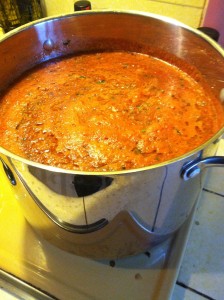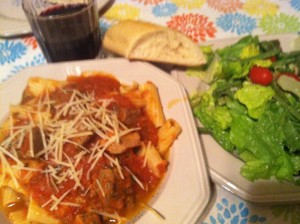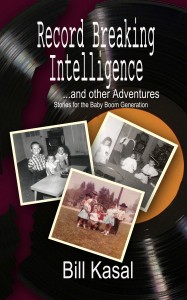The rain today patters on the roof, but I’m in Southern California so the temperatures accompanying the storm aren’t too low. Still, the sound of the rain and the dim light rouses the nesting instinct. On days like this, you yearn to pull on a warm sweater and curl up with a book—or Kindle!
Or you want to eat. In reality, almost any kind of weather makes me want to eat. It’s how I got into the shape I’m in today. Round is a shape! But putting on a pot of soup or stew for later in the day is, in itself, most comforting on these wet winter days.
I didn’t make soup or stew. The local market had Roma tomatoes on sale for 99¢-lb. so I bought quite a few pounds and am attempting to make some gravy from scratch. OK. Un-wrinkle your brow. I’m not talking about using tomatoes to make your typical Midwestern brown gravy. I’m talking about spaghetti sauce. Or, pasta sauce, as some call it.
 Nearly a century ago, my mother’s parents came to America from a suburb of Naples, Italy called Acerra. With them came recipes for making red, or tomato-based, sauce. Except, as they leaned to speak English—as immigrants did in those days—they thought the sauce that they put on pasta was called gravy. That’s what the Merrigans did. They put gravy on their food. So, if Americans put gravy on their food, then the red sauce they made for spaghetti and countless other dishes must be called gravy.
Nearly a century ago, my mother’s parents came to America from a suburb of Naples, Italy called Acerra. With them came recipes for making red, or tomato-based, sauce. Except, as they leaned to speak English—as immigrants did in those days—they thought the sauce that they put on pasta was called gravy. That’s what the Merrigans did. They put gravy on their food. So, if Americans put gravy on their food, then the red sauce they made for spaghetti and countless other dishes must be called gravy.
My mother spoke Italian as her first language and didn’t learn to speak English until she went to school and learned through necessity. Still, she was raised in America and soon spoke English to everyone except her parents and siblings. As my siblings and I grew up, we knew the red sauce was called sauce, but we also learned that my grandparents called it gravy and that is what we called it when we were at their house.
My father’s grandparents came to American from what was then Czechoslovakia. My father was raised on pork roast, sauerkraut and dumplings and, so we discovered as we grew, he didn’t like Italian food. Thinking about it as adults, we thought, “You don’t like Italian food, yet you marry an Italian girl…” Unfortunately, due to my dad’s disdain, we didn’t eat as much Italian food growing up as most of my friends assume.
My father’s family was in the Midwest and we were raised in California. We were closer in proximity to my mom’s family and those family gatherings, with the notable exception of barbeques on the Fourth of July, were predominantly Italian. Every once in a while I’ll get a whiff of something cooking with a certain mixture of Italian spices or seasonings and I’ll think, “That smells like my grandmother’s kitchen…”
I’ll tell you, quite happily, that the house is starting to smell like that right now. That’s a good sign for me that my gravy is going to turn out well.
A few decades ago, at a gathering of my cousins from the Italian side of my family, my cousin, Joe, called to me across a kitchen.
“Hey, Bill. What do you call this?” he pointed to the pot of sauce.
“Gravy,” I said.
“See?” he said to another cousin. I don’t know the specifics of their conversation, but I assumed he was telling her that we still carried some of the colloquialisms from our grandparents. I agree that we do, and I wish it were more. I wish I’d had time to learn to speak Napolitan so I could have spoken to my grandparents in their native tongue. My mother still uses short Italian phrases when she talks. When we cook, (I’m using phonetics here) a shcahlabast is a colander and a goopeen is a ladle.
Of course there’s agita which literally means to shake, but it’s used when your stomach is upset or agitated. “Dees guy! He geeva me dee agita!”
 I cannot find the translation for most of her phrases because of her Neapolitan/Acerran dialect and the slang they spoke. She’ll say something like “zote en gop,” which I’ve come to know means whatever she’s talking about is upside down. Or after a long story, she’ll sigh and say, “aqeece di oovat,” which roughly translates to, “and that’s the story.” There’s also “stata buon,” which literally means “that’s good.” But it is really said with the inflection of, “yeah, thanks for sharing…” or “take a hike, pal…”
I cannot find the translation for most of her phrases because of her Neapolitan/Acerran dialect and the slang they spoke. She’ll say something like “zote en gop,” which I’ve come to know means whatever she’s talking about is upside down. Or after a long story, she’ll sigh and say, “aqeece di oovat,” which roughly translates to, “and that’s the story.” There’s also “stata buon,” which literally means “that’s good.” But it is really said with the inflection of, “yeah, thanks for sharing…” or “take a hike, pal…”
When she says, “I got the ooli…” I know that ooli means she got the urge or craving for something. On this rainy day I got the ooli to make some gravy from scratch and eat a big bowl (or three) of rigatoni for dinner. In any language, it’s good!
– – – – –
OK! At the request of my friend, Dave Nicolson, I am including the recipe for my sauce. Warning: This is from scratch!
12 lbs Roma Tomatoes
3/4 cup olive oil
One bunch of Garlic
Fresh Basil
1/2 Bunch Fresh Italian Parsley
2 lbs Beef Stew Meat
1 lb Pork Stew Meat
Salt & Pepper
Pasta of choice
Bring a large pot of water to a rolling boil. With a paring knife, remove the stems from the tomatoes. Score the other end with an “x” cut, just enough to pierce the skin, but don’t worry if you go deeper. Add as many tomatoes as can comfortably fit into your pot of boiling water and let boil for two minutes. Remove them from the water and plunge them into iced or cold water. Repeat until all tomatoes have been blanched and cooled. Remove the skins and set the tomatoes aside.
Dry out your large pot (or get another) and add olive oil. Peel the garlic and roughly chop. Heat the olive oil on high heat and add the garlic to it. Let the garlic cook until it browns. DO NOT let it burn. Remove the pot from the heat and skim out the browned garlic and discard.
Put the oil back on high heat and add the beef and pork. Let the meat brown in the oil, stirring occasionally to ensure even browning.
While the meat is browning, begin placing tomatoes into a blender and liquefy. Once I have a blender about 3/4 or so full of liquid tomatoes, I drop in the bunch of Basil leaves and pulse a few times to chop the basil. Pour into the pot. On the next blender full of tomatoes, I add the half bunch of parsley and chop it the same way. Keep blending tomatoes until they are all liquefied and added to the pot.
Add about a teaspoon of black pepper and a tablespoon of salt. You can adjust that amount to your taste. All of this should fill a 12 quart pot. Keep on high heat and stir often until sauce comes to a boil, then turn down heat to low and let simmer for a few hours. You want it to at least cook down to about 3/4 of the original volume.
Follow the instructions on your pasta, cover with sauce and eat. I suggest a hearty noodle like rigatoni or penne or spaghetti. It’s a meat sauce so it needs a heartier noodle.
This makes enough for at least two pounds of pasta. It keeps in the fridge for a few days or you can freeze it. Or, if you don’t want so much, cut the recipe in half.
If you do not want to use fresh tomatoes, about six or eight of the large cans of whole tomatoes from the grocery store ought to do. You liquefy them one can at a time in the blender. However, most of the canned tomatoes are salted so watch your addition of salt if you used canned tomatoes.
OK? Mangia!


